Reviews
The Bienal de Sao Paulo Makes a Bold Attempt to Change the Way We Look at Art. Can It Work?
At a time of crisis in Brazil, curator Gabriel Pérez-Barreiro has eschewed spectacle for a much more contemplative, quiet biennial.
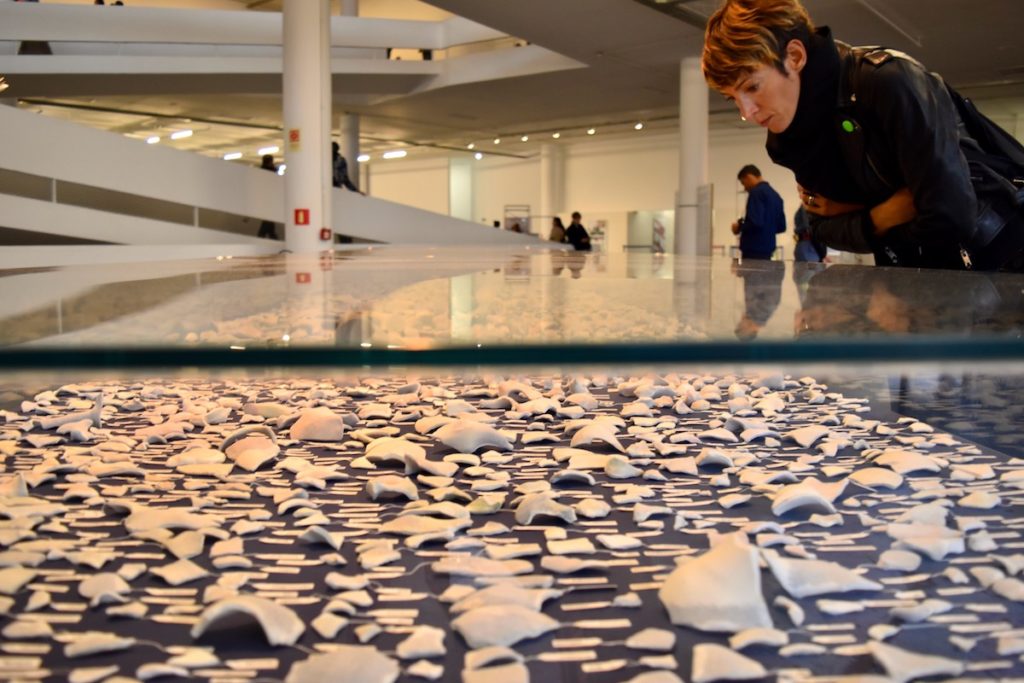
At a time of crisis in Brazil, curator Gabriel Pérez-Barreiro has eschewed spectacle for a much more contemplative, quiet biennial.

Ben Davis

The day I left New York to see the 33rd Bienal de Sao Paulo, the National Museum in Rio de Janeiro burned. The inferno destroyed hundreds of years of national heritage at a stroke. It was a stunning tragedy, and front-page news in Brazil and throughout the world.
It was also a perfectly symbolic event, because Brazil at large is burning, having passed through what some have called its worst-ever recession and with its government paralyzed by a corruption scandal that is historic in scope, even for Brazil.
On my final full day in Sao Paulo, a would-be assassin put a knife into the liver of presidential candidate Jair Bolsonaro, a hard-right populist who, among other things, made political hay demonizing a recent show of queer art in Rio. Now in a hospital bed, Bolsonaro has a wide lead in the polls. (ArtReview’s Oliver Basciano had a great summary of Brazil’s political situation in the run-up to the biennial.)
All this is a stunningly inflamed backdrop against which to open a big art event like the Bienal de Sao Paulo—and particularly striking in that “Affective Affinities,” as this 33rd edition of the oldest biennial in the hemisphere is titled, is very much not interested in entering into direct confrontation with it.
![The curators of the 33rd Bienal do Sao Paulo [left to right]:Alejandro Cesarco, Antonio Ballester Moreno, Claudia Fontes, Mamma Andersson, Gabriel Pérez-Barreiro Sofia Borges, Waltercio Caldas, and Wura-Natasha Ogunji. Image courtesy Ben Davis.](https://news.artnet.com/app/news-upload/2018/09/curators-affective-affinities-1024x645.jpg)
The curators of the 33rd Bienal de Sao Paulo [left to right]: Alejandro Cesarco, Antonio Ballester Moreno, Claudia Fontes, Mamma Andersson, Gabriel Pérez-Barreiro, Sofia Borges, Waltercio Caldas, and Wura-Natasha Ogunji. Image courtesy Ben Davis.
Instead, “Affective Affinities” is a biennial of deliberately and provocatively small claims.
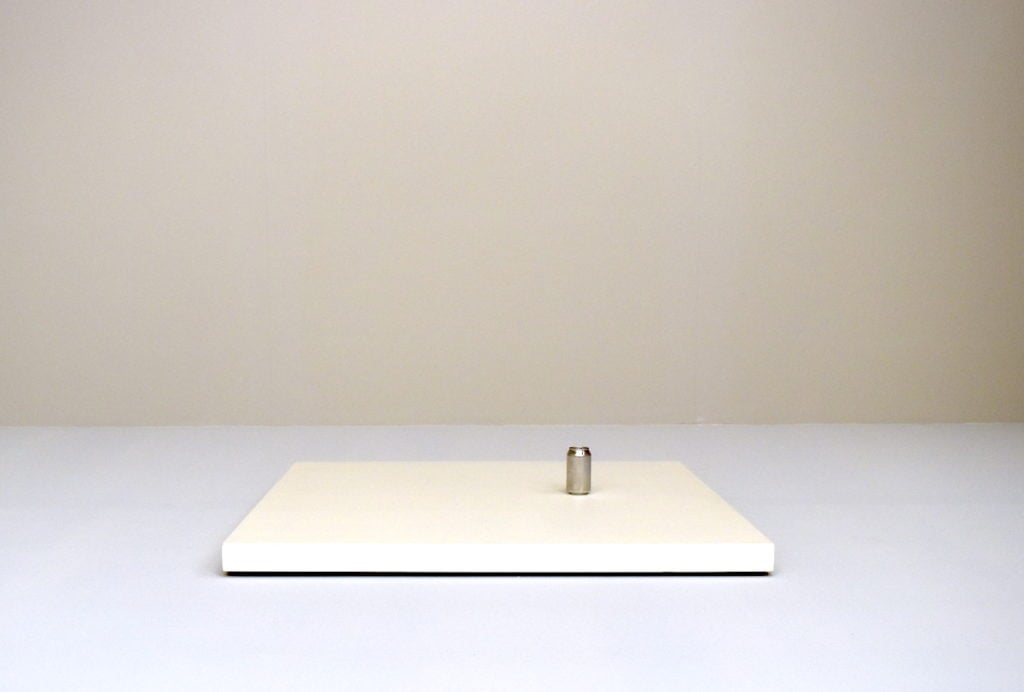
Lucia Nogueira, Refrain (1991-1998) in “Affective Affinities.” Image courtesy Ben Davis.
Pérez-Barreiro has filled the show with a variety of mini-exhibitions focusing on figures he sees as ripe for study or celebration, from the late Brazil-born, London-based Lucia Nogueira (1950–98), with her amusingly confounding, ultra-minimal work, to Argentina’s Feliciano Centurión (1962–96), maker of louche textiles, alternatively humorous and heartbroken.
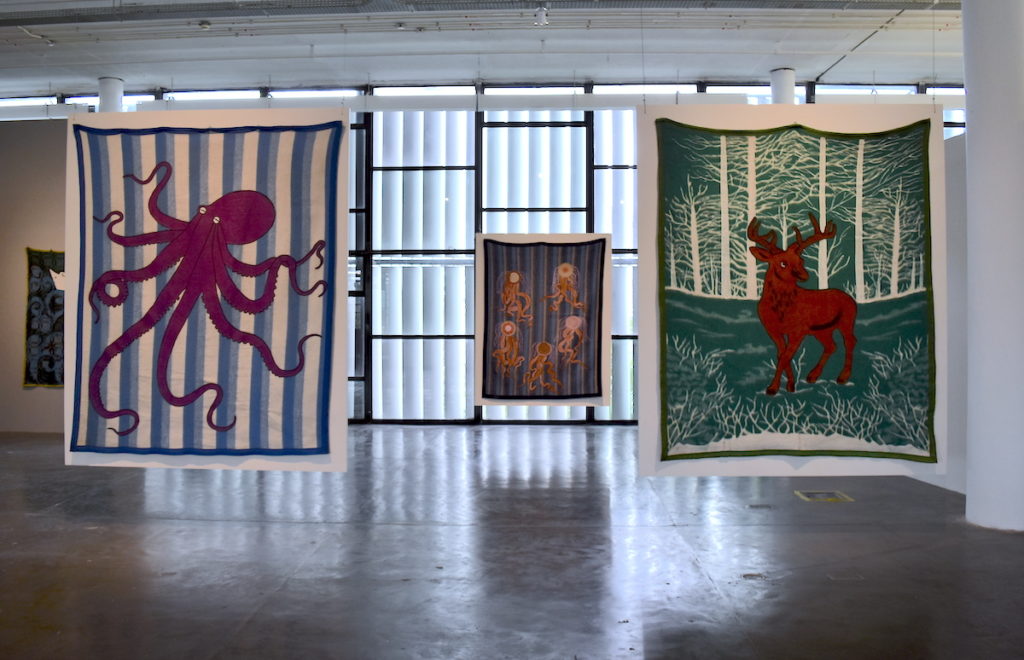
Works by Feliciano Centurión in “Affective Affinities.” Image courtesy Ben Davis.
But the chief curatorial gambit here is Pérez-Barreiro’s decision to select seven artists for his show—Mamma Andersson, Sofia Borges, Waltercio Caldas, Alejandro Cesarco, Claudia Fontes, Antonio Ballester Moreno, and Wura-Natasha Ogunji—and then delegate his job to them. Each was given a section of the vast Oscar Niemeyer-designed biennial pavilion in Ibirapuera Park and tasked with conceptualizing and orchestrating their own mini-show, incorporating their own work.
The result is an exhibition that shape-shifts as you go. It starts with Spanish artist Antonio Ballester Moreno’s section, an offbeat mixing of his own nature-inspired paintings and sculptures with an installation featuring live watercolorists illustrating specimens from the park, orchestrated by Mark Dion; a mini-retrospective of the “Valencia School” of Spanish figurative sculpture; and a collection of toys, games, and other materials related to Friedrich Fröbel, the inventor of kindergarten.
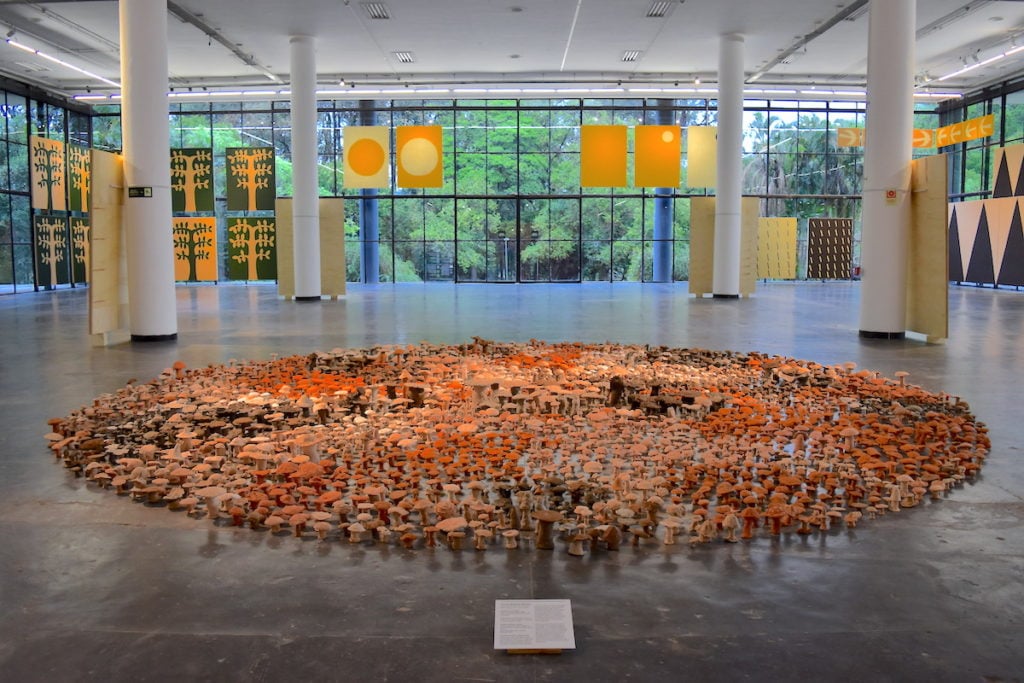
Installation view of works by Antonio Ballester Moreno, Vivan los campos libres (2018) in “Affective Affinities.” Image courtesy Ben Davis.
But walk to the other end of the building and the biennial is something else again. Brazilian artist Sofia Borges’s zone is installed like a Surrealist club house with heavy velvet curtains. Works by her selected artists—the twisted bodies of British sculptor Sarah Lucas, the intimately glyphic paintings of Ana Prata, the neon-studded assemblages of Jennifer Tee—repeat in different constellations throughout its nooks and crannies.
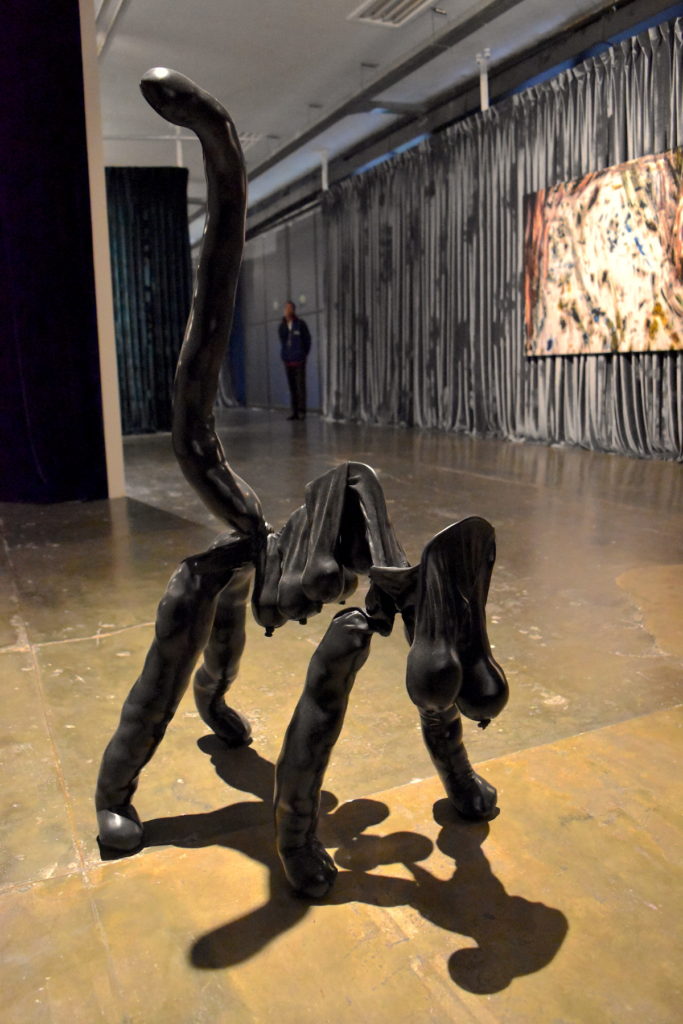
Sarah Lucas, Tit-Cat Up (2015). Image courtesy Ben Davis.
The key thing to note about all this is not actually Pérez-Barreiro’s gesture of delegation—biennials disperse authority to teams of curators all the time—but the fact that he has selected specifically artist-curators. The emphasis is squarely on dramatizing the element of personal taste or aesthetic sensibility.
(I’d describe these sensibilities, imperfectly, as something like this: Moreno = “sensuous intellectualism”; Borges = “hipster romanticism”; Fontes = “methodical dreaminess”; Ogunji = “lyrical corporeality”; Cesarco = “aloof criticality”; Andersson = “offbeat expressionism”; Caldas = “Eliotic conceptualism.”)
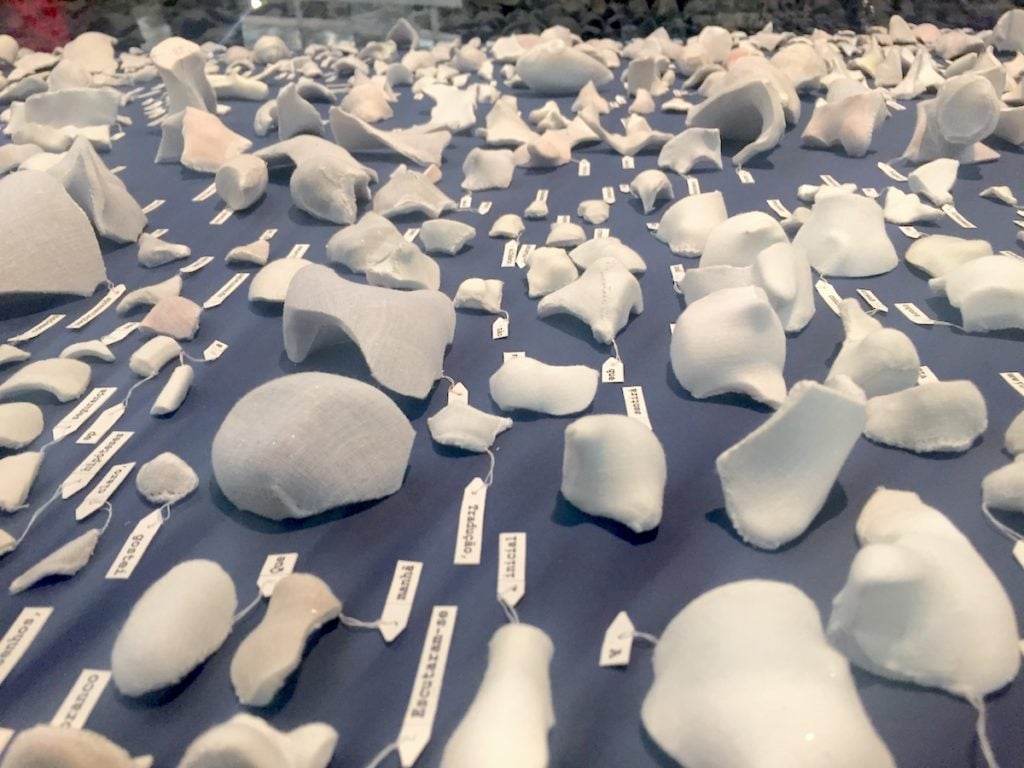
Detail of Claudia Fontes, Footnote (2018) work in “Affective Affinities.” Image courtesy Ben Davis.
There are many individual things I like: Argentinian artist Claudia Fontes’s own work featuring a glass display of smashed fragments of ceramic birds, rewrapped in cloth to disguise their original form, and presented alongside poetic labels; Sara Cwynar’s elliptical video on the politics of the color red (in Cesarco’s section “To Our Parents”); a wonderfully daffy stop-motion animation about adulterous insects, from 1912, by the Polish animator Ladislas Starewitch (in Andersson’s show); and so on.

Installation view of Sara Cwynar, Red Film in “Affective Affinities.” Image courtesy Ben Davis.
But what is is the effect of the experience as a whole?
That’s an interesting question, because Pérez-Barreiro’s gambit is as a kind of plea to take an approach to the show that is less categorical and overarching, more plural and discrete. Emphasizing the subjective dimensions of taste in its different sub-sections, it is as if “Affective Affinities” is pleading against the snap judgement of the jaded biennial viewer.
“If you were curating this, you would have to please all these constituencies—and look how different they are!” it seems to say.
“Dereliction of curatorial duty” is a phrase I heard grumbled in reaction to the show.
There may be something to that: I don’t know exactly what to make of the intro to Sofia Borges’s section, which pairs jumbo-sized black-and-white photos by Austrian priest and ethnographer Martín Gusinde of Tierra del Fuego’s indigenous inhabitants, from 1923, with a massive text fragment declaring “Before Everything It Was One.” But given the stream-of-consciousness, shamanistic rhetoric of Borges’s curatorial statement—”The infinity of everything was one. The unity of meaning was a circle. The void of the void was complete”—it seems to flirt with using indigenous people as a figure of the universal unconscious, a queasy gesture that someone should have questioned.
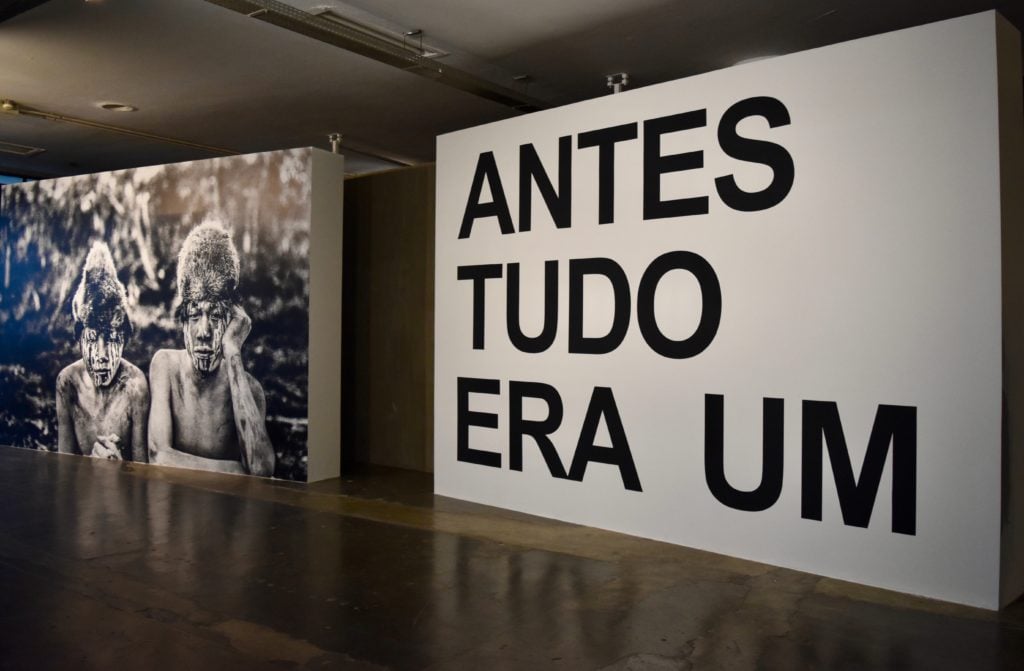
Installation view of the opening of Sofia Borges’s show in “Affective Affinities,” with Martín Gusinde, Arturón and Antonio (1923) at left. Image courtesy Ben Davis.
On a more nuts-and-bolts level, a lot of the art here feels overmatched and adrift in the grandiose pavilion, swamped by space.
Niemeyer’s pavilion is all about voluptuous architectural spectacle and sweeping continuous connection, while “Affective Affinities” is a show that aspires to something experimentally anti-spectacular and atomized. The effect is a bit like a wedding reception where you spent agonizing hours deciding who sits at which table—but you only invited a few close friends, and the venue is three floors of an immense cruise ship.
And yet this “low-density” approach is actually a very deliberate part of Pérez-Barreiro’s approach to the show. The pavilion infrastructure stands for the inflexibly big ambitions of culture, frozen in concrete. To an extent, then, the slightly lost feeling of the art here points to exactly the difficult recalibration of biennial expectations that the curator is trying to pull off.
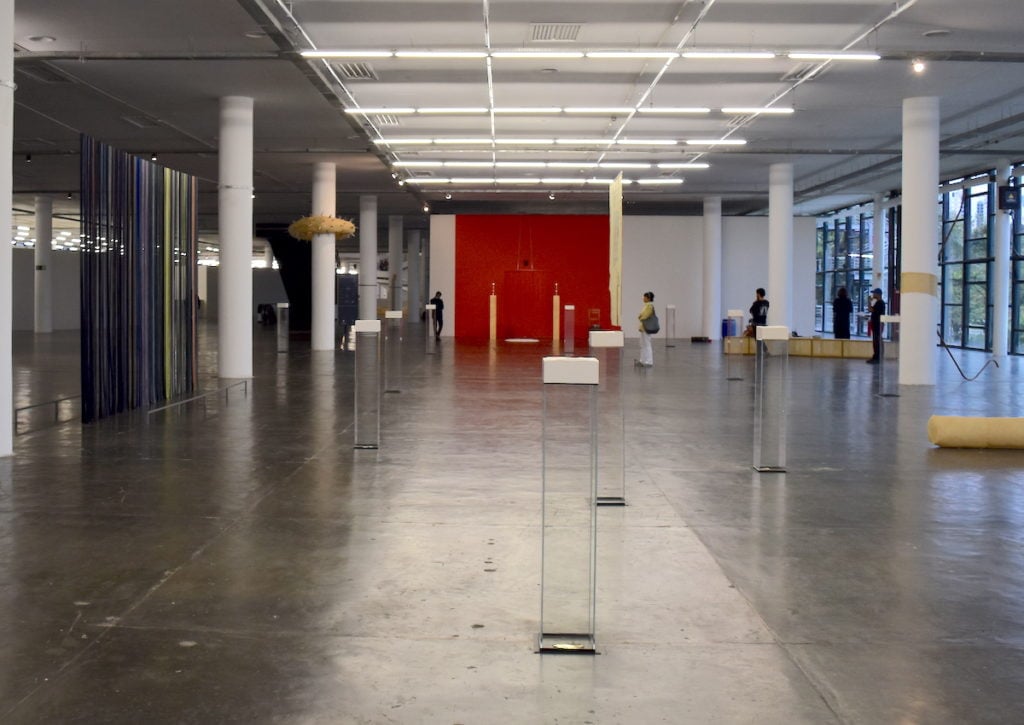
Installation view of Nicole Vlado’s artworks in “Affective Affinities.” Image courtesy Ben Davis.
New York-based artist-architect Nicole Vlado’s gold-accented minimal sculptures in Wura-Natasha Ogunji’s section more or less declare as much. At first, they barely register as artistic forms. Then you realize, upon inspection, that each matches an imperfection in Niemeyer’s floor, filled in with gold. Each piece is in fact raised on clear stellae above the corresponding crack or chink.
![A sculpture by Nicole Vlado [left]; and the detail of the floor that it is highlighting. Images courtesy Ben Davis.](https://news.artnet.com/app/news-upload/2018/09/nicole-vlado-1024x384.jpg)
“here” (I gaze at stars to heal wounds) (2018) by Nicole Vlado [left]; and the detail of the floor that it is highlighting. Images courtesy Ben Davis.
As I said, one way to think about this show is that it is stressing the partial and relative nature of taste through its plurality of visions. But on another level, this is definitely not what is going on, or only half of it: Pérez-Barreiro clearly has defined a sensibility for his biennial that carries throughout its different components.
Because his pick of collaborators is governed, clearly, not just by the need for a set of contrasts, but by an overarching sensibility of its own. You can see this, in relief, by what is not present in “Affective Affinities”—by the conspicuous absence not just of documentary work or allusions to current events, and a dialing down of contemporary art’s well-honed language of consciousness-raising and critique.
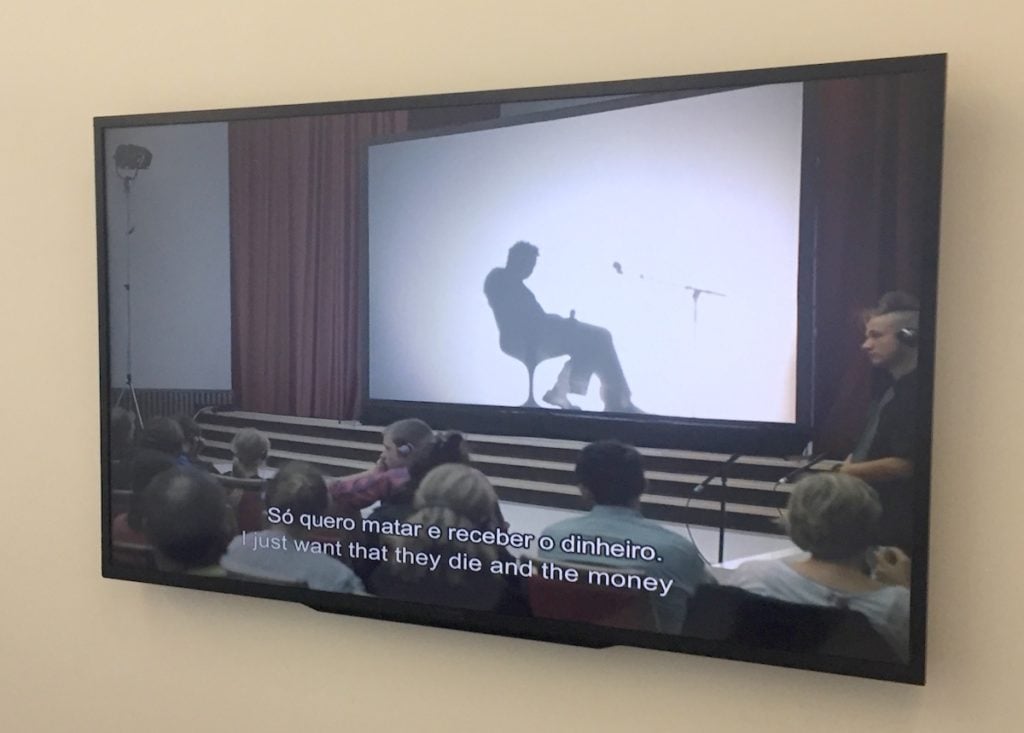
Installation view of Aníbal López, Testimonio (Sicario) (2012) in “Affective Affinities.” Image courtesy Ben Davis.
(The most dramatic exception that proves the rule arrives in one of Pérez-Barreiro’s mini-exhibitions, this one dedicated to the extraordinarily disconcerting work of the late Guatemalan political conceptualist Aníbal López. He once brought a professional killer to do a Q&A at a German biennial and claims to have mugged a middle-class person at gunpoint as an artwork—all of which shows, at the limit, just how dangerously deep you have to cut to startle the art audience.)
A centerpiece in Pérez-Barreiro’s “Affective Affinities” is the French artist Tal Isaac Hadad’s Recital for masseur (recital para um massagista). For the performance, a small cluster of performers stood, in an inward-facing circle, singing a sort of aimless sacral drone.
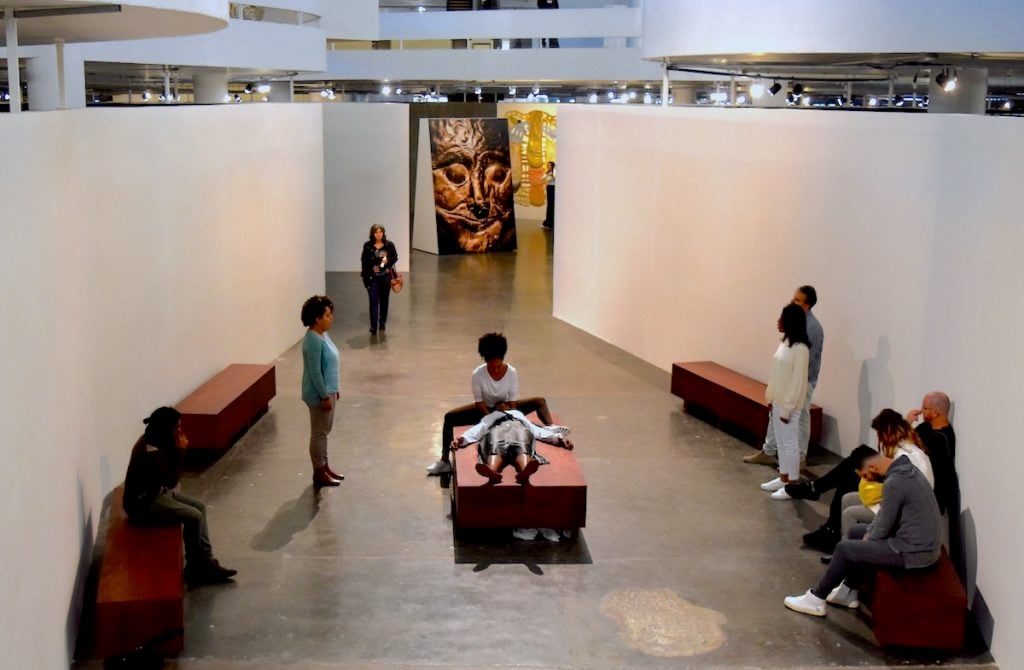
Tal Issac Hadad, Recital Para um massagista. Image courtesy Ben Davis.
One, a massage therapist, would engage a singer (the “soloist”), who was instructed to react with his or her voice as the therapist located points of tension or knots. The rest of the performers, observing, amplified the patient’s reactions.
The result filled the pavilion with a unique music, a shared representation of art as a slow, deliberate finding of pressure points, long passages of breathy limbo punctuated by upwellings of emotion and release.
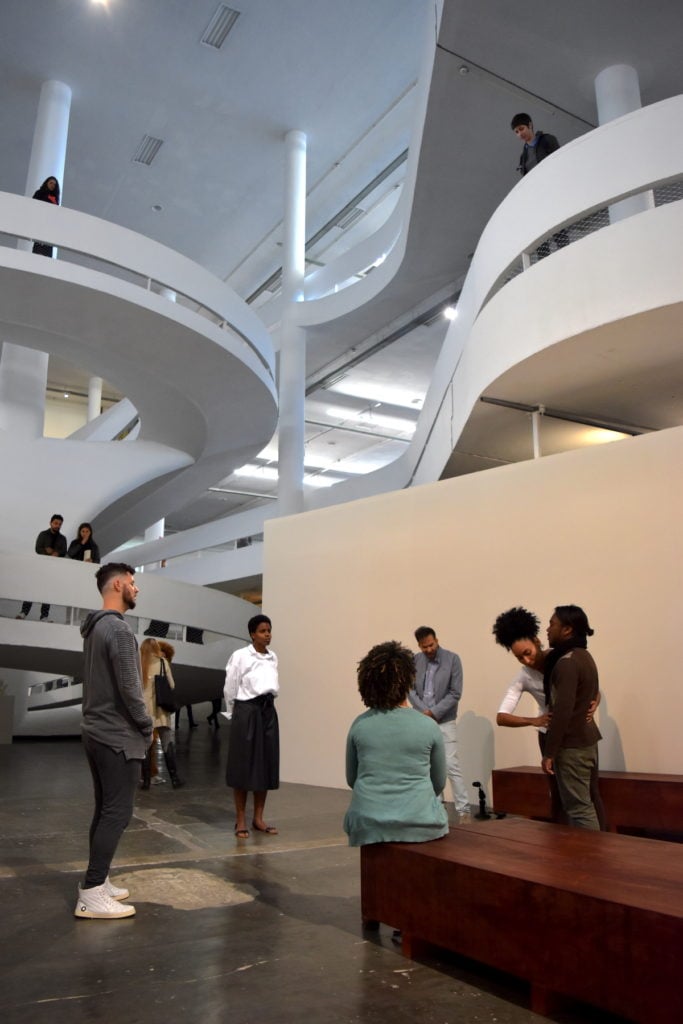
Tal Issac Hadad, Recital Para um massagista. Image courtesy Ben Davis.
Such is the ultimate intended rhythm of “Affective Affinities,” whose underlying sensibility is intimate and anti-spectacular, and unfolds as a series of metaphors for the value of going through a process to find small knots of epiphany.
In the long run, the key gesture of the 33rd Bienal may not be the whole Team of Rivals/artist-curator thing, but instead another thematic choice that runs through the educational programming around the event and puts a bow on the intended effect: the decision to focus on problems of attention rather than problems of interpretation, to frame “art and its exhibitions as experiences and not as declarations,” as Pérez-Barreiro puts it. (The official show guide even opens with a list of suggested protocols and activities for approaching and concentrating on individual artworks.)
I think this will likely be something of a trend.
The history of contemporary art has been one long process of art slowly bringing into focus different aspects that seemed peripheral, then internalizing them as the point or subject matter of the art itself: in conceptualism, it was the documentation of artworks; in site-specific art, it was spaces of display; in performance art, the body of the maker and its social conditions.
And I think it likely that the conditions of attention are next, becoming a focus of art-making: “attention-specific art” instead of “site-specific art.”
I predict that this will be the case not just because the apparatuses of the attention-capture economy are ever-more difficult to escape, but also because the particularly alarming state of the world means that the torrent of news alerts is relentless. That sense of constant emergency makes it very difficult to focus on things that are not directly plugged into the roller-coaster rhythm of the news cycle—something nowhere so true as in Brazil right now.
That surrounding reality may well make it seem as if cultivating the particular decelerated headspace to which “Affective Affinities” aspires is a luxury for people who have the leisure to look away from current events, a charge that Pérez-Barreiro’s show will be open to.
Yet today’s endless slurry of bad news mixed with frenetic entertainment—which is replicated in the intellectual, optical, and spatial overload of a lot of international art shows—tends to render the mind frantic. It paralyzes extended analysis by the same measure that it overpowers any more-than-superficial aesthetic experience. And so, art’s use as a space to train attention may be less superfluous than it seems, and worth salvaging.
In that sense, Pérez-Barreiro’s precarious experiment is very relevant indeed, even as it arrives exactly in the hour of crisis when it is most difficult to pull off.
“Affective Affinities,” the 33rd Bienal de Sao Paulo, is on view through December 9, 2018.